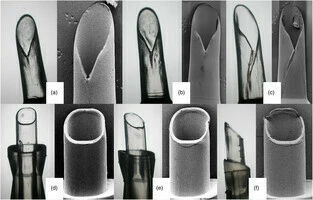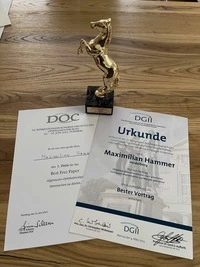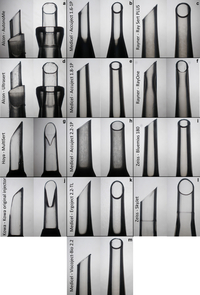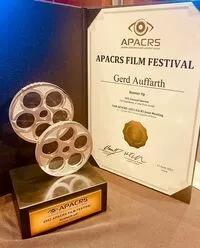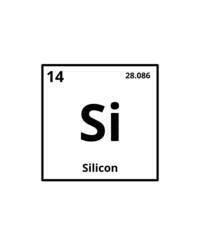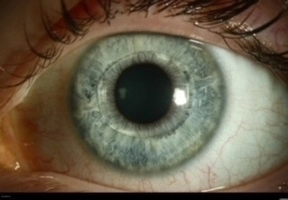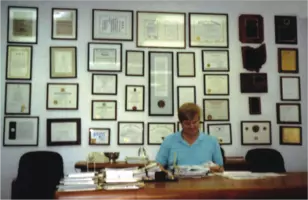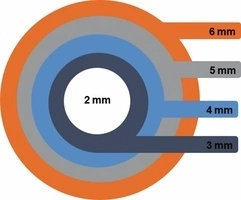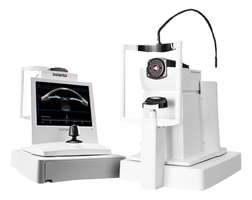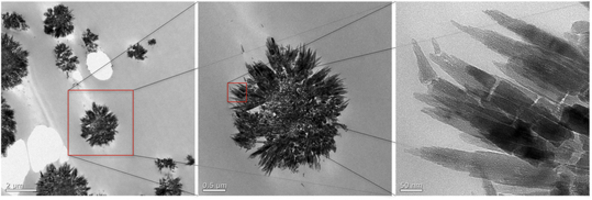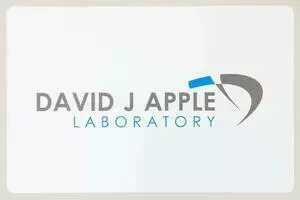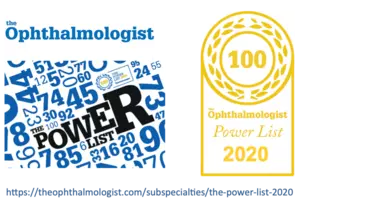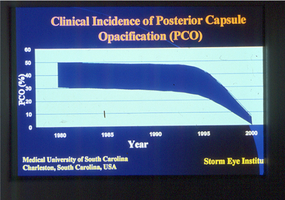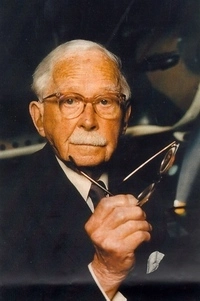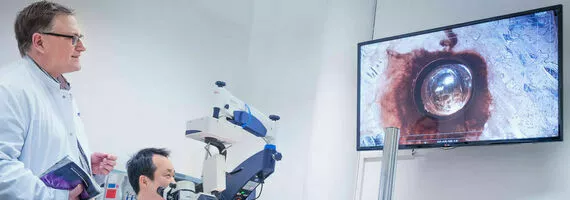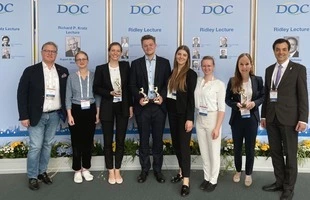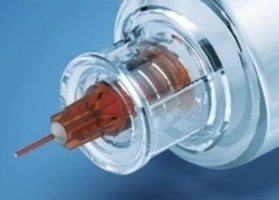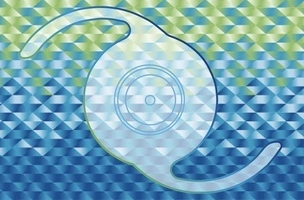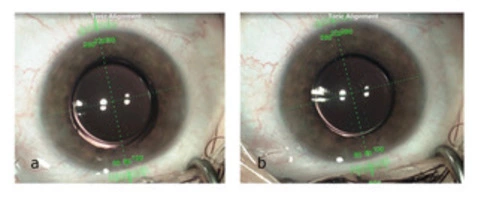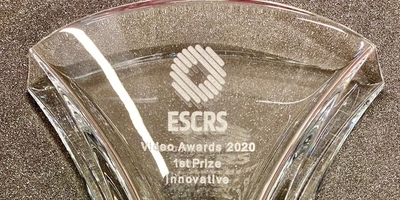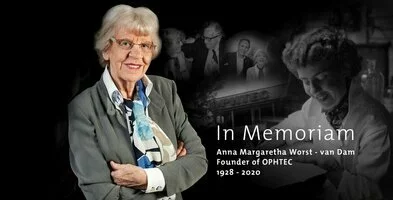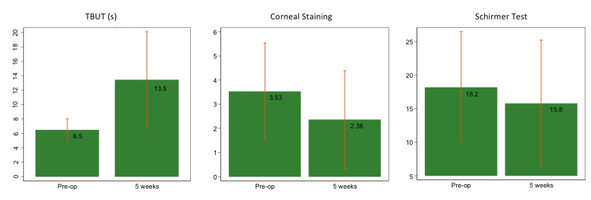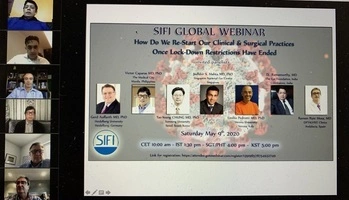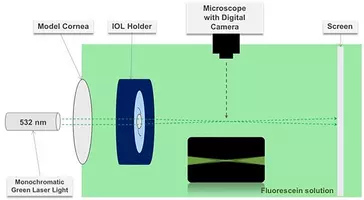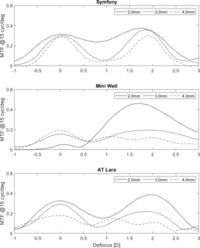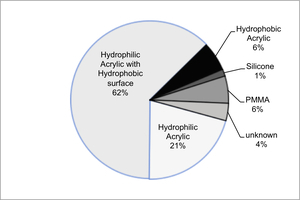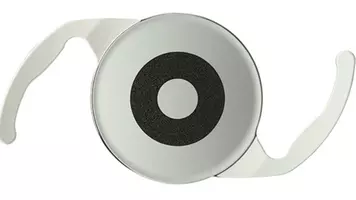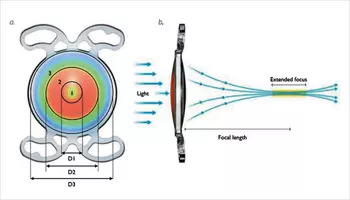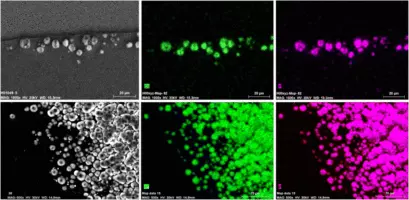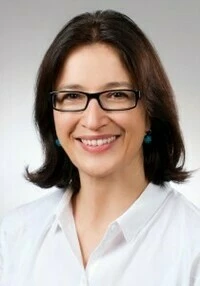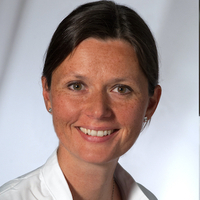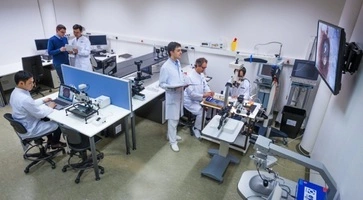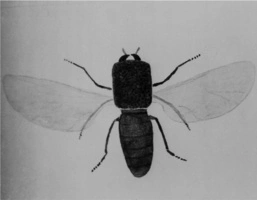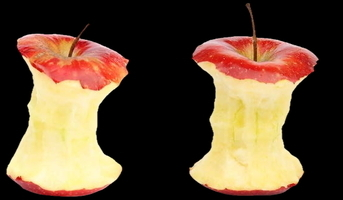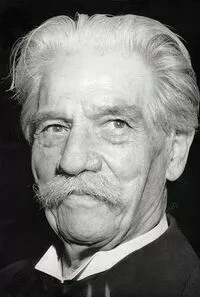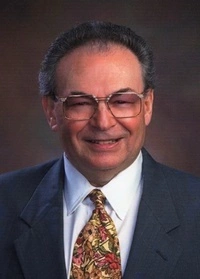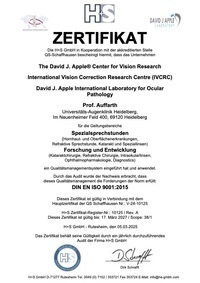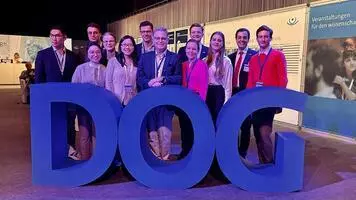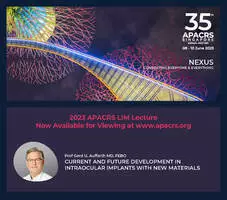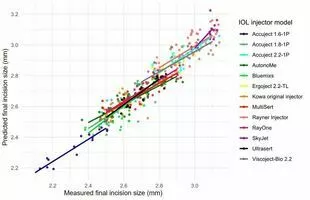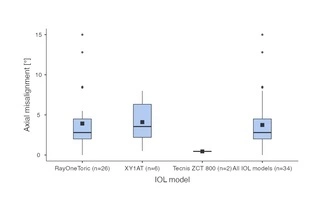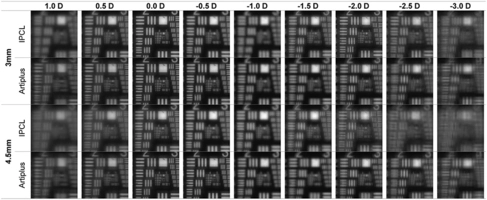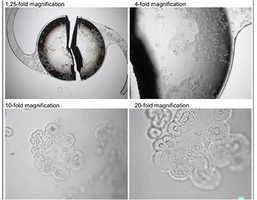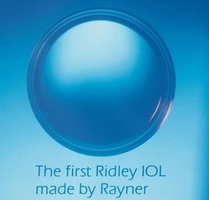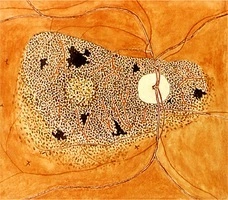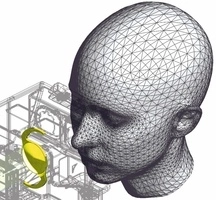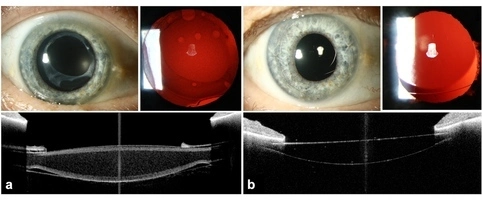Categories
lab
Comparing Multisert and AutonoMe.
Comparing Multisert and AutonoMe IOL injectors, a study found both allowed safe implantation, but Multisert showed more consistent behavior and less injector damage.
In lab, news, Sep 26, 2023Introducing Dynamic Stimulation Aberrometry
Researchers introduced dynamic stimulation aberrometry (DSA) to objectively measure binocular accommodation in 91 patients, finding that accommodative amplitude decreases with age and that DSA records pupil motility dynamically.
In lab, news, , Apr 29, 2023Recommending realistic incision sizes!
A recent study analyzed the recommended incision sizes of 13 intraocular lens injector systems in cataract surgery, finding that manufacturers' recommendations often lead to intraoperative incision enlargement, and in some cases, require larger incisions than recommended.
In lab, news, Feb 16, 2023We're Recruiting!
The David J Apple Center for Vision Research is recruiting a student researcher to work on new projects involving material science applications for posterior segment ocular disease. The position involves laboratory bench research, rheological analyses, and Wet Lab surgery projects, with the possi...
In lab, news, Jan 23, 2023Prize-winning AAO 2022
Dr. Gerd Auffarth receives the AAO Life Achievement Honor Award in Chicago, marking 30 years since his first attendance. He is also recognized for his video "CSI Heidelberg - A view from Inside," which won the Grand Prize of the AAO Global Video Contest.
In lab, news, Sep 29, 2022Merci beaucoup Philippe
Professor Philippe Sourdille delivered the 1st David J. Apple MD Memorial Lecture, "Events I Have Witnessed Over Many Years," at the University-Eye-Clinic in Heidelberg, Germany, sharing a fascinating journey through decades of ophthalmic research and technology.
In lab, news, Jul 18, 2022Silicone oil drug delivery
"Intravitreal Application: Physicochemical Properties of Drugs Dissolved in Silicone Oils of Different Density in Comparison to the Porcine Vitreous Body" by Hammer et al. (2022) investigates the distribution of anti-infective drugs in silicone oil-filled eyes compared to natural porcine vitreous...
In lab, news, Jul 12, 2022Breaking news from Seoul
The David J Apple Laboratory won a prize at the APACRS Film Festival for "CSI Heidelberg: A view from inside," a video showcasing the laboratory's work in a CSI-style format.
In lab, news, Jun 11, 2022Announcement: Prof. Auffarth to present the 2022 Ernst Bodenheimer Memorial Lecture.
Prof. Gerd U. Auffarth, MD, PhD, delivered the 2022 Ernst Bodenheimer Memorial Lecture on "Corneal Treatments and Surgery 2022: What We are Doing Differently" at the Wilmer Eye Institute, Johns Hopkins University.
In lab, news, Apr 27, 2022Physico-chemical parameters of Silicone Oil
The study examined the effects of biological media on silicone oil used as an intraocular tamponade in retinal detachment surgery. It found that prolonged exposure to the eye does not alter the oil's physicochemical parameters, but the addition of high-molecular-weight components may decrease emu...
In lab, news, Feb 06, 2022Pupil dynamics
This study compares pupil size after three different strategies for intraocular lens (IOL) fixation: anterior iris-fixation, retropupillary iris-fixation, and in-the-bag implantation. The results show that all three strategies do not impair pupil constriction in normal light conditions, but retro...
In publication, lab, Nov 26, 2021The Nuc'Cracker
ESCRS offers educational resources, including the "ESCRS 100" video series, live streaming of cataract surgery, and the ESCRS IOL Calculator.
In lab, news, Oct 10, 2021The 80th anniversary of David Apple
David J. Apple was a renowned ophthalmic pathologist who made significant contributions to the field of intraocular lens (IOL) research and ophthalmic surgery. He was a medical historian and biographer of Sir Harold Ridley, the inventor of the IOL. Apple founded the Center for Developing World Op...
In lab, history, Sep 14, 2021Singapore winner!
CSI Heidelberg Episode 4: DMEK with EndoArt, a prize-winning video, showcases the innovative EndoArt artificial implant used in place of human donor tissue for Descemet membrane endothelial keratoplasty (DMEK).
In lab, news, Aug 01, 2021Comparing preloaded IOL-injector systems
The study compared a new intraocular lens (IOL) injector system, multiSert, against three standard injector systems in porcine eyes. The results showed that multiSert achieved better results in incision enlargement, ease of use, delivery time, and performance when used with the appropriate incisi...
In lab, news, Jun 15, 2021Corneal Centre to Periphery: Astigmatism Changes
The study analyzed corneal topography data from 641 elderly patients to assess mid-peripheral astigmatism. It found that central corneal astigmatism differs from mid-peripheral measurements, with a greater difference in patients with against-the-rule, oblique, and high astigmatism. The magnitude ...
In lab, news, Apr 08, 2021Using ANTERION® to assess IOL opacification.
Researchers used high-resolution optical coherence tomography to study the correlation between localized calcification on intraocular lenses and straylight, finding a significant link between the two.
In lab, news, Mar 29, 2021Supplementary IOL calcification
Researchers analyzed explanted intraocular lenses from polypseudophakic eyes with supplementary sulcus-supported lenses, finding calcification in both capsular bag and supplementary lenses, with varying morphology and patterns related to environmental factors and comorbidities.
In lab, research, Jul 27, 2020Prizewinning work on Infra-red vision
The Rupp+Hubrach Science Prize 2020 was awarded to Asu Rayamajhi for their Master's thesis on measuring infrared-light visibility thresholds in diabetic and healthy patients using a two-photon ophthalmoscope.
In lab, news, Jun 22, 2020Chinese presentation
The text discusses David J. Apple's laboratory experience and how ophthalmologists can contribute to the innovative development of artificial crystalline lenses. It includes a link to a presentation by Prof. Auffarth, which is in English, and thanks Eyebright for compiling and translating the con...
In lab, news, Jun 21, 2020Powerlist2020: Auffarth
"The Ophthalmologist" magazine published a "Ranking" of the "100 most influential personalities in ophthalmology worldwide" This list is updated every two years, since 2014, and once again, Prof Gerd Auffarth is listed. The ranking includes not just eye surgeons but the research scientists and en...
In lab, news, Apr 06, 2020Eradicating PCO
Gerd Auffarth celebrates David Apple's landmark paper on eradicating posterior capsule opacification, highlighting its significance in reducing YAG laser procedures and improving cataract surgery techniques.
In lab, news, Mar 29, 2020Welcome 2020: New website
The David J Apple Lab celebrates the new year with a revamped website featuring contributor-based content on IOL research and history. They look forward to the ESCRS Congress in Amsterdam and reflect on their successful 2019, marked by publications in peer-reviewed journals on IOL studies.
In lab, news, Jan 01, 202070th IOL anniversary
"Today marks the 70th anniversary of Sir Harold Ridley's groundbreaking implantation of the first intraocular lens (IOL) at St. Thomas's Hospital in London on November 29, 1949."
In history, lab, Nov 29, 2019Steinbeis Center
The David J Apple Center for Vision Research is a Steinbeis Research Center focused on intraocular devices, with research and clinical work managed within the center.
In lab, news, Mar 01, 2016(Archive) Welcome Patrick
Dr. Patrick Merz, a research biotechnologist with six years of experience, joins the David J Apple International Laboratory for Ocular Pathology as Laboratory Leader, overseeing research programs and managing facilities.
In lab, news, May 01, 2015Why Heidelberg?
Heidelberg University is a public research university in Germany, founded in 1386. It is known for its strong research tradition, with 55 Nobel Prize winners affiliated with the university. The university has two main campuses, one in the Old Town and another in Neuenheimer Feld, which houses the...
In history, lab, Oct 24, 2012Moving to Heidelberg.
“For us, it is a great honour to be able to carry on the legacy of this great man,” says the CEO of the company. “We are proud to be part of the project,’ he adds, “and we are looking forward to working with the team.”
In lab, news, Sep 11, 2012news
Appeal for Nepal
Today marks the 70th anniversary of Sir Harold Ridley’s pioneering intraocular lens (IOL) operation, performed at St Thomas’s Hospital in London on November 29, 1949.
In news, Nov 29, 2023Comparing Multisert and AutonoMe.
Comparing Multisert and AutonoMe IOL injectors, a study found both allowed safe implantation, but Multisert showed more consistent behavior and less injector damage.
In lab, news, Sep 26, 2023Overcoming implantation challenges with SING IMT
The SING IMT is a second-generation implantable miniature telescope designed to improve visual acuity and quality of life in patients with late-stage age-related macular degeneration (AMD). It features a smaller incision and improved surgical techniques compared to its predecessor. The device has...
In news, Aug 01, 2023Introducing Dynamic Stimulation Aberrometry
Researchers introduced dynamic stimulation aberrometry (DSA) to objectively measure binocular accommodation in 91 patients, finding that accommodative amplitude decreases with age and that DSA records pupil motility dynamically.
In lab, news, , Apr 29, 2023Recommending realistic incision sizes!
A recent study analyzed the recommended incision sizes of 13 intraocular lens injector systems in cataract surgery, finding that manufacturers' recommendations often lead to intraoperative incision enlargement, and in some cases, require larger incisions than recommended.
In lab, news, Feb 16, 2023We're Recruiting!
The David J Apple Center for Vision Research is recruiting a student researcher to work on new projects involving material science applications for posterior segment ocular disease. The position involves laboratory bench research, rheological analyses, and Wet Lab surgery projects, with the possi...
In lab, news, Jan 23, 2023Nepal Appeal
"Remember 29th November 1949, the day Sir Harold Ridley implanted the first intraocular lens (IOL) at St. Thomas’s Hospital in London, marking a significant milestone in ophthalmology."
In news, Nov 29, 2022Prize-winning AAO 2022
Dr. Gerd Auffarth receives the AAO Life Achievement Honor Award in Chicago, marking 30 years since his first attendance. He is also recognized for his video "CSI Heidelberg - A view from Inside," which won the Grand Prize of the AAO Global Video Contest.
In lab, news, Sep 29, 2022Merci beaucoup Philippe
Professor Philippe Sourdille delivered the 1st David J. Apple MD Memorial Lecture, "Events I Have Witnessed Over Many Years," at the University-Eye-Clinic in Heidelberg, Germany, sharing a fascinating journey through decades of ophthalmic research and technology.
In lab, news, Jul 18, 2022Silicone oil drug delivery
"Intravitreal Application: Physicochemical Properties of Drugs Dissolved in Silicone Oils of Different Density in Comparison to the Porcine Vitreous Body" by Hammer et al. (2022) investigates the distribution of anti-infective drugs in silicone oil-filled eyes compared to natural porcine vitreous...
In lab, news, Jul 12, 2022Platinum Performance!
The German Congress of Ophthalmic Surgeons (DOC) in Nuremberg, Germany, on June 25, 2022, was the largest face-to-face meeting in three years with 5,400 delegates. Researchers from the David J Apple Center for Vision Research in Heidelberg won four of the seven "Conference Best Paper Awards," wit...
In laboratory, news, Jun 26, 2022Breaking news from Seoul
The David J Apple Laboratory won a prize at the APACRS Film Festival for "CSI Heidelberg: A view from inside," a video showcasing the laboratory's work in a CSI-style format.
In lab, news, Jun 11, 2022Announcement: Prof. Auffarth to present the 2022 Ernst Bodenheimer Memorial Lecture.
Prof. Gerd U. Auffarth, MD, PhD, delivered the 2022 Ernst Bodenheimer Memorial Lecture on "Corneal Treatments and Surgery 2022: What We are Doing Differently" at the Wilmer Eye Institute, Johns Hopkins University.
In lab, news, Apr 27, 2022Physico-chemical parameters of Silicone Oil
The study examined the effects of biological media on silicone oil used as an intraocular tamponade in retinal detachment surgery. It found that prolonged exposure to the eye does not alter the oil's physicochemical parameters, but the addition of high-molecular-weight components may decrease emu...
In lab, news, Feb 06, 2022Polyimide cannulas
Researchers compared the injection times of high-viscosity silicone oils using polyimide and metal cannulas. Polyimide cannulas significantly reduced injection times, allowing for the use of ultra-high-viscosity oils, and prewarming the oil further decreased injection times.
In research on silicone oil, news, Feb 06, 2022In memory of Emanuel Rosen
Emanuel Rosen, a renowned ophthalmic surgeon, left a lasting impact on the field of cataract and refractive surgery. He was a unifying force, introducing key elements like ESCRS, JCRS, and EuroTimes, which continue to support global development in the field.
In news, Nov 23, 2021Xactitude!
This study evaluates the xact Mono-EDoF ME4 IOL, a new hybrid monofocal lens with extended depth of focus, in 28 patients undergoing cataract surgery. The results show good functional outcomes for far and intermediate distance visual acuity and low levels of photic phenomena.
In clinical, news, Oct 12, 2021The Nuc'Cracker
ESCRS offers educational resources, including the "ESCRS 100" video series, live streaming of cataract surgery, and the ESCRS IOL Calculator.
In lab, news, Oct 10, 2021Singapore winner!
CSI Heidelberg Episode 4: DMEK with EndoArt, a prize-winning video, showcases the innovative EndoArt artificial implant used in place of human donor tissue for Descemet membrane endothelial keratoplasty (DMEK).
In lab, news, Aug 01, 2021Comparing preloaded IOL-injector systems
The study compared a new intraocular lens (IOL) injector system, multiSert, against three standard injector systems in porcine eyes. The results showed that multiSert achieved better results in incision enlargement, ease of use, delivery time, and performance when used with the appropriate incisi...
In lab, news, Jun 15, 2021Corneal Centre to Periphery: Astigmatism Changes
The study analyzed corneal topography data from 641 elderly patients to assess mid-peripheral astigmatism. It found that central corneal astigmatism differs from mid-peripheral measurements, with a greater difference in patients with against-the-rule, oblique, and high astigmatism. The magnitude ...
In lab, news, Apr 08, 2021Using ANTERION® to assess IOL opacification.
Researchers used high-resolution optical coherence tomography to study the correlation between localized calcification on intraocular lenses and straylight, finding a significant link between the two.
In lab, news, Mar 29, 2021IOL fixed to the capsulotomy!
A European multicenter trial found that a new IOL fixed to a femtosecond laser-made capsulotomy resulted in less decentration, tilt, and rotation, providing excellent visual and refractive outcomes over 12 months.
In Clinical , news, Feb 27, 2021Reversible Trifocality
A 49-year-old woman underwent bilateral exchange of a supplementary trifocal sulcus-fixated intraocular lens to correct a residual refractive error six months after the initial duet procedure. The exchange improved her uncorrected distance visual acuity and allowed for complete spectacle independ...
In clinical, news, Dec 01, 2020Remember 29th November!
"Today, November 29, 2020, marks the 71st anniversary of Sir Harold Ridley's first implantation of an intraocular lens (IOL) at St Thomas's Hospital in London on November 29, 1949."
In news, history, Nov 29, 2020CSI: Heidelberg. Episode 4 DMEK with EndoArt®
The EndoArt, an artificial endothelial replacement membrane, has shown promising results in treating chronic corneal edema. This dome-shaped, 50-μm thick implant is made of a flexible, hydrophilic acrylic material and is designed to replace the diseased endothelium. It is implanted using the "pus...
In news, Clinical, Oct 11, 20204. Heidelberger Helmholtztage, 27 & 28 November
The 4th Heidelberg Helmholtz Days will take place on November 27-28, 2020, as a hybrid meeting at the Palatin Congress and Cultural Centre in Wiesloch, Heidelberg. The event will have 150 in-person attendees and offer live online lectures, with a focus on current topics related to Hermann Helmhol...
In event, news, Oct 03, 2020Pinhole Xtrafocus
Heidelberg University Eye Clinic successfully treated a patient with radial keratotomy 22 years prior using a Morcher Xtrafocus lens, correcting fluctuating residual refraction after cataract surgery.
In Clinical, news, Sep 01, 2020The aesthetics of iris reconstruction
A study evaluated the aesthetic outcome of iris reconstruction using a custom-made artificial iris prosthesis in patients with traumatic partial or total aniridia. The results showed good aesthetic outcomes, with patients, eye doctors, and laymen rating the overall aesthetic outcome highly. Pupil...
In laboratory, news, Aug 18, 2020IOL sutured to an Artificial Iris - does it affect the IOL's optics?
Researchers assessed the optical quality of monofocal intraocular lenses (IOLs) sutured to an artificial iris, finding that while the lenses' modulation transfer function (MTF) decreased slightly, the changes were clinically irrelevant.
In laboratory, news, Aug 05, 2020Anneke Worst (1928-2020)
Ophtec, a Dutch IOL manufacturer, was founded by Jan and Anneke Worst. Anneke Worst passed away in 2020, and the company continues to innovate with products like the Precizon Go IOL.
In ophthalmology, news, Aug 04, 2020Dry eye drops
Evaporative dry eye (EDE) is a common condition where tears evaporate too quickly, causing discomfort, irritation, and blurred vision. It is often caused by meibomian gland dysfunction, which can be treated with warm compresses, thermal pulsation, intense pulsed light, and meibomian gland probing...
In clinical, news, Aug 03, 2020Prizewinning work on Infra-red vision
The Rupp+Hubrach Science Prize 2020 was awarded to Asu Rayamajhi for their Master's thesis on measuring infrared-light visibility thresholds in diabetic and healthy patients using a two-photon ophthalmoscope.
In lab, news, Jun 22, 2020Chinese presentation
The text discusses David J. Apple's laboratory experience and how ophthalmologists can contribute to the innovative development of artificial crystalline lenses. It includes a link to a presentation by Prof. Auffarth, which is in English, and thanks Eyebright for compiling and translating the con...
In lab, news, Jun 21, 2020After Lock-down - how to re-start?
The webinar, "SIFI Global Webinar," held on May 9, 2020, discussed the challenges of restarting cataract surgery after lockdown restrictions due to the COVID-19 pandemic. The panel, consisting of seven surgeons from Asia and Europe, covered topics such as patient interview protocols, COVID-19 tes...
In news, COVID 19, May 11, 2020Powerlist2020: Auffarth
"The Ophthalmologist" magazine published a "Ranking" of the "100 most influential personalities in ophthalmology worldwide" This list is updated every two years, since 2014, and once again, Prof Gerd Auffarth is listed. The ranking includes not just eye surgeons but the research scientists and en...
In lab, news, Apr 06, 2020Eradicating PCO
Gerd Auffarth celebrates David Apple's landmark paper on eradicating posterior capsule opacification, highlighting its significance in reducing YAG laser procedures and improving cataract surgery techniques.
In lab, news, Mar 29, 2020Visualising rays in IOLs
The study visualized and analyzed the optical performance of four intraocular lens (IOL) models using a ray propagation imaging technique and modulation transfer function (MTF) measurements. The IOLs included a monofocal, bifocal, trifocal, and extended-depth-of-focus (EDOF) lens. The results sho...
In research, news, Feb 05, 2020EDOF IOL research
This study compares the image quality of three extended depth-of-focus (EDOF) intraocular lens models in monochromatic and polychromatic light. The results show that EDOF IOLs are more resistant to chromatic effects and provide better through-focus performance than monofocal IOLs, but differences...
In research , news, Jan 20, 2020Reasons for explanting IOLs
The Apple Lab research team analyzed 200 intraocular lens (IOL) explants, finding that the main reasons for explantation were IOL opacification (76.5%) and dislocation (13.5%). Most explants were hydrophilic acrylic lenses from a single manufacturer.
In research, news, Jan 18, 2020Welcome 2020: New website
The David J Apple Lab celebrates the new year with a revamped website featuring contributor-based content on IOL research and history. They look forward to the ESCRS Congress in Amsterdam and reflect on their successful 2019, marked by publications in peer-reviewed journals on IOL studies.
In lab, news, Jan 01, 2020Wolfgang Haigis: in memoriam
Prof. Dr. Wolfgang Haigis, a renowned physicist, passed away on October 15, 2019, at the age of 72. He was a pioneer in biometry and developed the Haigis formula, used globally for cataract surgery.
In innovator, news, Oct 18, 2019Small-aperture IOL results.
Researchers evaluated the visual outcomes of 13 cataract patients with a small-aperture IOL in one eye and a segmental-refractive bifocal IOL in the other, showing improved binocular visual results and minimal photic phenomena.
In research, news, Sep 12, 2019Straylight from glistenings
Glistenings in hydrophobic acrylic intraocular lenses (IOLs) are fluid-filled microvacuoles that can negatively impact visual function. Studies have shown that severe glistenings can mildly reduce contrast sensitivity and visual acuity. The formation of glistenings is highly dependent on IOL mate...
In publication, news, Jul 01, 2019CSI:Heidelberg Episode 2
"CSI Heidelberg Episode 2 focuses on multifocal and EDOF (Extended Depth of Focus) intraocular lens (IOL) technology, highlighting their features, benefits, and challenges.
In news, publication, Oct 01, 2018Functional results and photic phenomena with Mini WELL Ready IOL
The study evaluated the clinical outcomes of the Mini WELL Ready extended-depth-of-focus intraocular lens (EDOF-IOL) in 14 cataract patients. The lens provided good postoperative functional results at far and intermediate distances, with high rates of spectacle independence and satisfaction in ev...
In news, publication, Aug 28, 2018Optical Quality July 1, 2018
New research from the David J Apple Lab reveals that pars plana vitrectomy with gas injection increases the risk of secondary calcification in hydrophilic acrylic intraocular lenses, necessitating IOL exchange.
In publication, news, Jul 01, 2018Lab at ASCRS•ASOA ANNUAL MEETING (Washington DC)
The David J Apple Laboratory will be exhibiting at the 2018 ASCRS-ASOA Annual Meeting in Washington, DC, at booth 762.
In news, Apr 14, 2018Hydrophilic acrylic IOLs and Lamellar keratoplasty
Researchers at the David J Apple International Laboratory for Ocular Pathology analyzed 13 hydrophilic intraocular lenses (IOLs) that became opacified after posterior lamellar keratoplasty, finding that the opacification was caused by calcium phosphate deposits on the IOL surface. This opacificat...
In news, publication, Aug 22, 2017(ARCHIVE) 2016 Heidelberg Helmholtz Symposium
The 2016 Heidelberg Helmholtz Symposium, hosted by the David J Apple Center for Vision Research, features workshops and presentations on contemporary ophthalmology topics, with all didactic sessions in German.
In news, Oct 24, 2016CSI: Heidelberg Episode 3
"CSI Heidelberg Episode 3 focuses on multifocal and extended depth-of-focus (EDOF) intraocular lens (IOL) technology, highlighting the differences and working principles of various presbyopia-correcting IOLs."
In news, publication, Aug 30, 2016CSI:Heidelberg Episode 1
The Winner - Best Video at the annual meeting of ESCRS 2018 in Vienna. This is the first epsiode of a series about the work done in the laboratory. The first video was shot in a CSI: Crime Scene Investigation style. The video series informs the viewer how we operate.
In news, publication, Aug 30, 2016(ARCHIVE) Welcome Lucia
Dr. Lucia Poggi, a cell biology leader, has joined the David J Apple International Laboratory for Ocular Pathology. She has a background in cellular-resolution microscopy and researches in-vivo cell biology, focusing on asymmetric cell division and fate identity acquisition during ocular developm...
In staff, news, Jul 15, 2016(ARCHIVE) Welcome Sonja
The David J Apple International Laboratory for Ocular Pathology is a leading research center for intraocular devices, continuing the work of renowned expert David J Apple. The lab focuses on improving IOL design, materials, and implantation techniques to avoid complications.
In staff, news, Jul 01, 2016Steinbeis Center
The David J Apple Center for Vision Research is a Steinbeis Research Center focused on intraocular devices, with research and clinical work managed within the center.
In lab, news, Mar 01, 2016Albert Galand 1938 - 2015.
Albert Galand (1938-2015) was a pioneer in capsular IOL design and intra-capsular techniques. He developed novel capsulotomy methods, including the envelope technique, and designed lenses for capsular implantation. Galand was a strong advocate for in-the-bag fixation of IOLs and organized interna...
In pioneer, news, Jan 06, 2016Seasonal greetings
The David J Apple Laboratory extends seasonal greetings, wishing clients and friends a Merry Christmas and a peaceful, prosperous, and healthy New Year. They look forward to working together in 2016.
In news, Dec 23, 2015New Look for the Lab
Apple has expanded its use of recycled materials across its products, including 59% recycled aluminum, 45% certified recycled rare earth elements, and 30% certified recycled tin. The company aims to use only renewable or recyclable materials in its products and has made significant progress towar...
In news, Nov 02, 2015(Archive) Welcome Patrick
Dr. Patrick Merz, a research biotechnologist with six years of experience, joins the David J Apple International Laboratory for Ocular Pathology as Laboratory Leader, overseeing research programs and managing facilities.
In lab, news, May 01, 2015Opacification after rTPA
The David J Apple Lab team and UK clinicians published a study on intraocular lens opacification after intracameral injection of recombinant tissue plasminogen activator to treat inflammatory membranes following cataract surgery.
In news, publication, Mar 18, 2015DGII Award for Mary Attia
Dr. Mary Safwat Aziz Attia, an ophthalmologist at Heidelberg University Clinic, won the "Best Paper of the Session" award at the 2015 DGII meeting for her research on multifocal IOLs using the Salzburg Reading Desk.
In research, news, Mar 11, 2015Feast for Eye and Ear
Prof. Dr. med. Gerd Auffarth, Head of the DJApple Lab, drew a record 730 attendees to his "Medicine in the Evening" lecture on ophthalmology, sponsored by the Rhein Neckar Zeitung.
In news, Jan 25, 2015The Ridleys visit the Lab
The Ridley Eye Foundation works to cure blindness in Nepal by providing small incision cataract surgery to those in need. The foundation collaborates with local hospitals and organizations to provide medical care and restore sight to people in remote areas.
In news, Dec 22, 2014Boston ASCRS.
Dr. Ramin Khoramnia won the Runner-Up prize in the Cataract Complications category at the 2014 ASCRS Films Awards Ceremony for his film "CSI: Heidelberg-IOL Analysis." He also received the ASCRS Foundation's 2014 Resident Excellence Award, recognizing his outstanding performance in research, pati...
In news, Apr 30, 2014Better vision for AMD patients.
Oculentis Lentis Mplus High Add IOL is a hydrophobic acrylic biconvex IOL which has a +8 D sector-shaped near addition resulting in 6 D of near correction at the spectacle plane and 1.5 times magnifying power. “It provides image magnification for near — quite useful for AMD patients who normally ...
In clinical, news, Apr 03, 2014Congratulations, Ramin!
Ramin Khoramnia, a Research Fellow from The Apple Lab, achieved second place in the European Board of Ophthalmology's 2013 exam, demonstrating exceptional knowledge and skills in ophthalmology.
In staff, news, Aug 29, 2013Crossing an Ocean – the laboratory that moved
The David J Apple Lab, led by Professor Gerd U. Auffarth, has relocated from Charleston, South Carolina to the University Eye Department of the University of Heidelberg. The lab aims to create an international research center for intraocular ophthalmic devices, continuing and expanding the work i...
In news, Nov 02, 2012Moving to Heidelberg.
“For us, it is a great honour to be able to carry on the legacy of this great man,” says the CEO of the company. “We are proud to be part of the project,’ he adds, “and we are looking forward to working with the team.”
In lab, news, Sep 11, 2012history
Flies, Blinding Worms, Spitting snakes!
Ridley's 1944 radio broadcast about his field trip to Funsi, (RiverBlindness is eradicated in Ghana now) and Ridley's snake venom paper
In history, Nov 26, 2024Two Apple cores
The core of the laboratory is the people who do the research. While David Apple was alive, he called his researchers the **Apple Korps**. Now one can talk of a New Generation of **Auffarth-Apple Korps**.
In lab news, history, Mar 01, 2023The 80th anniversary of David Apple
David J. Apple was a renowned ophthalmic pathologist who made significant contributions to the field of intraocular lens (IOL) research and ophthalmic surgery. He was a medical historian and biographer of Sir Harold Ridley, the inventor of the IOL. Apple founded the Center for Developing World Op...
In lab, history, Sep 14, 2021Remember 29th November!
"Today, November 29, 2020, marks the 71st anniversary of Sir Harold Ridley's first implantation of an intraocular lens (IOL) at St Thomas's Hospital in London on November 29, 1949."
In news, history, Nov 29, 202070th IOL anniversary
"Today marks the 70th anniversary of Sir Harold Ridley's groundbreaking implantation of the first intraocular lens (IOL) at St. Thomas's Hospital in London on November 29, 1949."
In history, lab, Nov 29, 2019A Lab with history
David J. Apple was a renowned ophthalmic pathologist who significantly improved the world of ophthalmology through his groundbreaking research on intraocular lens (IOL) complications and ophthalmic surgery. He founded the Center for Developing World Ophthalmology and was a medical historian, biog...
In history, Aug 01, 2013Why Heidelberg?
Heidelberg University is a public research university in Germany, founded in 1386. It is known for its strong research tradition, with 55 Nobel Prize winners affiliated with the university. The university has two main campuses, one in the Old Town and another in Neuenheimer Feld, which houses the...
In history, lab, Oct 24, 2012news lab history
The Legend of Albert Schweitzer
Albert Schweitzer (1875 – 1965) was multi-talented: a theologian, a doctor of medicine, a church organist, philosopher, pacifist and a philanthropist. Schweitzer received the 1952 Nobel Peace Prize in 1952 for his contribution to philosophy of "Reverence for Life."
In news lab history, Feb 21, 2013staff
(ARCHIVE) Welcome Lucia
Dr. Lucia Poggi, a cell biology leader, has joined the David J Apple International Laboratory for Ocular Pathology. She has a background in cellular-resolution microscopy and researches in-vivo cell biology, focusing on asymmetric cell division and fate identity acquisition during ocular developm...
In staff, news, Jul 15, 2016(ARCHIVE) Welcome Sonja
The David J Apple International Laboratory for Ocular Pathology is a leading research center for intraocular devices, continuing the work of renowned expert David J Apple. The lab focuses on improving IOL design, materials, and implantation techniques to avoid complications.
In staff, news, Jul 01, 2016Congratulations, Ramin!
Ramin Khoramnia, a Research Fellow from The Apple Lab, achieved second place in the European Board of Ophthalmology's 2013 exam, demonstrating exceptional knowledge and skills in ophthalmology.
In staff, news, Aug 29, 2013clinical
Xactitude!
This study evaluates the xact Mono-EDoF ME4 IOL, a new hybrid monofocal lens with extended depth of focus, in 28 patients undergoing cataract surgery. The results show good functional outcomes for far and intermediate distance visual acuity and low levels of photic phenomena.
In clinical, news, Oct 12, 2021Reversible Trifocality
A 49-year-old woman underwent bilateral exchange of a supplementary trifocal sulcus-fixated intraocular lens to correct a residual refractive error six months after the initial duet procedure. The exchange improved her uncorrected distance visual acuity and allowed for complete spectacle independ...
In clinical, news, Dec 01, 2020Dry eye drops
Evaporative dry eye (EDE) is a common condition where tears evaporate too quickly, causing discomfort, irritation, and blurred vision. It is often caused by meibomian gland dysfunction, which can be treated with warm compresses, thermal pulsation, intense pulsed light, and meibomian gland probing...
In clinical, news, Aug 03, 2020Better vision for AMD patients.
Oculentis Lentis Mplus High Add IOL is a hydrophobic acrylic biconvex IOL which has a +8 D sector-shaped near addition resulting in 6 D of near correction at the spectacle plane and 1.5 times magnifying power. “It provides image magnification for near — quite useful for AMD patients who normally ...
In clinical, news, Apr 03, 2014research
Supplementary IOL calcification
Researchers analyzed explanted intraocular lenses from polypseudophakic eyes with supplementary sulcus-supported lenses, finding calcification in both capsular bag and supplementary lenses, with varying morphology and patterns related to environmental factors and comorbidities.
In lab, research, Jul 27, 2020Visualising rays in IOLs
The study visualized and analyzed the optical performance of four intraocular lens (IOL) models using a ray propagation imaging technique and modulation transfer function (MTF) measurements. The IOLs included a monofocal, bifocal, trifocal, and extended-depth-of-focus (EDOF) lens. The results sho...
In research, news, Feb 05, 2020Reasons for explanting IOLs
The Apple Lab research team analyzed 200 intraocular lens (IOL) explants, finding that the main reasons for explantation were IOL opacification (76.5%) and dislocation (13.5%). Most explants were hydrophilic acrylic lenses from a single manufacturer.
In research, news, Jan 18, 2020Small-aperture IOL results.
Researchers evaluated the visual outcomes of 13 cataract patients with a small-aperture IOL in one eye and a segmental-refractive bifocal IOL in the other, showing improved binocular visual results and minimal photic phenomena.
In research, news, Sep 12, 2019Light scattering
Researchers at the David J Apple Lab studied glistening formation and light scattering in six hydrophobic-acrylic intraocular lenses, finding glistenings in five models but not in the Kowa IOL.
In research, publication, Sep 14, 2018DGII Award for Mary Attia
Dr. Mary Safwat Aziz Attia, an ophthalmologist at Heidelberg University Clinic, won the "Best Paper of the Session" award at the 2015 DGII meeting for her research on multifocal IOLs using the Salzburg Reading Desk.
In research, news, Mar 11, 2015publication
Pupil dynamics
This study compares pupil size after three different strategies for intraocular lens (IOL) fixation: anterior iris-fixation, retropupillary iris-fixation, and in-the-bag implantation. The results show that all three strategies do not impair pupil constriction in normal light conditions, but retro...
In publication, lab, Nov 26, 2021Straylight from glistenings
Glistenings in hydrophobic acrylic intraocular lenses (IOLs) are fluid-filled microvacuoles that can negatively impact visual function. Studies have shown that severe glistenings can mildly reduce contrast sensitivity and visual acuity. The formation of glistenings is highly dependent on IOL mate...
In publication, news, Jul 01, 2019CSI:Heidelberg Episode 2
"CSI Heidelberg Episode 2 focuses on multifocal and EDOF (Extended Depth of Focus) intraocular lens (IOL) technology, highlighting their features, benefits, and challenges.
In news, publication, Oct 01, 2018Light scattering
Researchers at the David J Apple Lab studied glistening formation and light scattering in six hydrophobic-acrylic intraocular lenses, finding glistenings in five models but not in the Kowa IOL.
In research, publication, Sep 14, 2018Functional results and photic phenomena with Mini WELL Ready IOL
The study evaluated the clinical outcomes of the Mini WELL Ready extended-depth-of-focus intraocular lens (EDOF-IOL) in 14 cataract patients. The lens provided good postoperative functional results at far and intermediate distances, with high rates of spectacle independence and satisfaction in ev...
In news, publication, Aug 28, 2018EDOF wavelength dependence
The latest paper from the David J Apple Lab, titled "The Effect of a Spectral Filter on Visual Quality in Patients with an Extended-Depth-Of-Focus Intraocular Lens," has been accepted for publication in the American Journal of Ophthalmology. The study examines the impact of spectral filters on vi...
In publication, Aug 19, 2018Optical Quality July 1, 2018
New research from the David J Apple Lab reveals that pars plana vitrectomy with gas injection increases the risk of secondary calcification in hydrophilic acrylic intraocular lenses, necessitating IOL exchange.
In publication, news, Jul 01, 2018A dip into our Archives
Multifocal intraocular lenses (IOLs) have advanced significantly, offering improved visual outcomes and spectacle independence after cataract surgery. These lenses divide light into different focuses, enhancing near vision but potentially causing halos, glare, and lower contrast sensitivity. Rece...
In publication, Sep 07, 2017Hydrophilic acrylic IOLs and Lamellar keratoplasty
Researchers at the David J Apple International Laboratory for Ocular Pathology analyzed 13 hydrophilic intraocular lenses (IOLs) that became opacified after posterior lamellar keratoplasty, finding that the opacification was caused by calcium phosphate deposits on the IOL surface. This opacificat...
In news, publication, Aug 22, 2017CSI: Heidelberg Episode 3
"CSI Heidelberg Episode 3 focuses on multifocal and extended depth-of-focus (EDOF) intraocular lens (IOL) technology, highlighting the differences and working principles of various presbyopia-correcting IOLs."
In news, publication, Aug 30, 2016CSI:Heidelberg Episode 1
The Winner - Best Video at the annual meeting of ESCRS 2018 in Vienna. This is the first epsiode of a series about the work done in the laboratory. The first video was shot in a CSI: Crime Scene Investigation style. The video series informs the viewer how we operate.
In news, publication, Aug 30, 2016Opacification after rTPA
The David J Apple Lab team and UK clinicians published a study on intraocular lens opacification after intracameral injection of recombinant tissue plasminogen activator to treat inflammatory membranes following cataract surgery.
In news, publication, Mar 18, 2015IOL history obituary
Jan Worst 1928 to 2015
Jan Worst, a pioneer in intraocular lens (IOL) design and co-founder of Ophtec, died on September 25, 2015, in Groningen, Netherlands. He developed the iris claw lens and phakic IOLs, and his company, Ophtec, became a leading manufacturer of IOLs.
In IOL history obituary, Sep 29, 2015pioneer
Albert Galand 1938 - 2015.
Albert Galand (1938-2015) was a pioneer in capsular IOL design and intra-capsular techniques. He developed novel capsulotomy methods, including the envelope technique, and designed lenses for capsular implantation. Galand was a strong advocate for in-the-bag fixation of IOLs and organized interna...
In pioneer, news, Jan 06, 2016innovator
Wolfgang Haigis: in memoriam
Prof. Dr. Wolfgang Haigis, a renowned physicist, passed away on October 15, 2019, at the age of 72. He was a pioneer in biometry and developed the Haigis formula, used globally for cataract surgery.
In innovator, news, Oct 18, 2019research
EDOF IOL research
This study compares the image quality of three extended depth-of-focus (EDOF) intraocular lens models in monochromatic and polychromatic light. The results show that EDOF IOLs are more resistant to chromatic effects and provide better through-focus performance than monofocal IOLs, but differences...
In research , news, Jan 20, 2020News
Congratulations Max!
Maximilian Hammer, a research student at the David J Apple Lab, won the 2020 MLP Medical Excellence Scholarship in the "Science" category, a 4000-euro award for outstanding German medical students.
In Laboratory, News, Nov 26, 2020DGII Mainz
The 34th Annual Congress of the DGII was held in Mainz, Germany, from February 13 to 15, 2020. The event featured presentations from the Apple Lab and the Eye Department in Heidelberg, with several team members winning awards for their research on intraocular lenses and optics.
In News, Feb 15, 2020COVID 19
After Lock-down - how to re-start?
The webinar, "SIFI Global Webinar," held on May 9, 2020, discussed the challenges of restarting cataract surgery after lockdown restrictions due to the COVID-19 pandemic. The panel, consisting of seven surgeons from Asia and Europe, covered topics such as patient interview protocols, COVID-19 tes...
In news, COVID 19, May 11, 2020ophthalmology
Anneke Worst (1928-2020)
Ophtec, a Dutch IOL manufacturer, was founded by Jan and Anneke Worst. Anneke Worst passed away in 2020, and the company continues to innovate with products like the Precizon Go IOL.
In ophthalmology, news, Aug 04, 2020laboratory
Platinum Performance!
The German Congress of Ophthalmic Surgeons (DOC) in Nuremberg, Germany, on June 25, 2022, was the largest face-to-face meeting in three years with 5,400 delegates. Researchers from the David J Apple Center for Vision Research in Heidelberg won four of the seven "Conference Best Paper Awards," wit...
In laboratory, news, Jun 26, 2022The aesthetics of iris reconstruction
A study evaluated the aesthetic outcome of iris reconstruction using a custom-made artificial iris prosthesis in patients with traumatic partial or total aniridia. The results showed good aesthetic outcomes, with patients, eye doctors, and laymen rating the overall aesthetic outcome highly. Pupil...
In laboratory, news, Aug 18, 2020IOL sutured to an Artificial Iris - does it affect the IOL's optics?
Researchers assessed the optical quality of monofocal intraocular lenses (IOLs) sutured to an artificial iris, finding that while the lenses' modulation transfer function (MTF) decreased slightly, the changes were clinically irrelevant.
In laboratory, news, Aug 05, 2020Clinical
CSI: Heidelberg. Episode 4 DMEK with EndoArt®
The EndoArt, an artificial endothelial replacement membrane, has shown promising results in treating chronic corneal edema. This dome-shaped, 50-μm thick implant is made of a flexible, hydrophilic acrylic material and is designed to replace the diseased endothelium. It is implanted using the "pus...
In news, Clinical, Oct 11, 2020Pinhole Xtrafocus
Heidelberg University Eye Clinic successfully treated a patient with radial keratotomy 22 years prior using a Morcher Xtrafocus lens, correcting fluctuating residual refraction after cataract surgery.
In Clinical, news, Sep 01, 2020event
4. Heidelberger Helmholtztage, 27 & 28 November
The 4th Heidelberg Helmholtz Days will take place on November 27-28, 2020, as a hybrid meeting at the Palatin Congress and Cultural Centre in Wiesloch, Heidelberg. The event will have 150 in-person attendees and offer live online lectures, with a focus on current topics related to Hermann Helmhol...
In event, news, Oct 03, 2020Laboratory
Congratulations Max!
Maximilian Hammer, a research student at the David J Apple Lab, won the 2020 MLP Medical Excellence Scholarship in the "Science" category, a 4000-euro award for outstanding German medical students.
In Laboratory, News, Nov 26, 2020Research
Glistening through the years
Study quantifies the decrease in glistening formation in Alcon's hydrophobic acrylic intraocular lenses over the past three decades, with the new Clareon material showing the lowest number of microvacuoles.
In Research, History, Feb 05, 2021History
Glistening through the years
Study quantifies the decrease in glistening formation in Alcon's hydrophobic acrylic intraocular lenses over the past three decades, with the new Clareon material showing the lowest number of microvacuoles.
In Research, History, Feb 05, 2021Clinical
IOL fixed to the capsulotomy!
A European multicenter trial found that a new IOL fixed to a femtosecond laser-made capsulotomy resulted in less decentration, tilt, and rotation, providing excellent visual and refractive outcomes over 12 months.
In Clinical , news, Feb 27, 2021research on silicone oil
Polyimide cannulas
Researchers compared the injection times of high-viscosity silicone oils using polyimide and metal cannulas. Polyimide cannulas significantly reduced injection times, allowing for the use of ultra-high-viscosity oils, and prewarming the oil further decreased injection times.
In research on silicone oil, news, Feb 06, 2022lab news
Team VitreoSub is a winner!
The provided sources discuss various topics related to the vitreous body and retinal care. The vitreous body is a gel-like substance that fills the posterior chamber of the eye, maintaining the eyeball's shape. Vitreous Retina Macula Consultants of New York (VRMNY) is involved in clinical trials ...
In lab news, Dec 13, 2023DOG 2023 -Group Photo
The annual congress of the German Society of Ophthalmology (D.O.G.) took place on September 29, 2023, in Berlin, featuring a group photo of ophthalmologists from hospitals, medical centers, and research centers, including the David J Apple Center for Vision Research.
In lab news, Sep 29, 2023APACRS LIM Lecture
Prof. Gerd U. Auffarth delivered the 2023 APACRS LIM Lecture, discussing current and future developments in intraocular implants with new materials at the 35th APACRS Annual Meeting in Singapore.
In lab news, Aug 12, 2023Enlarged incisions – but why?
Researchers analyzed 409 incisions from 13 IOL injector models to identify factors affecting final incision size in cataract surgery, finding that injector tip diameter, preoperative incision size, insertion depth, and incision length significantly impact final incision size.
In lab news, Jun 29, 2023DOC23 Success
The David J Apple Laboratory celebrates success at the 35th International Congress of German Ophthalmic Surgery (DOC) in Nuremberg, where research fellows Leonie Britz and Max Hammer won "Best Paper of Session" Awards for their lectures.
In lab news, Jun 20, 2023Two Apple cores
The core of the laboratory is the people who do the research. While David Apple was alive, he called his researchers the **Apple Korps**. Now one can talk of a New Generation of **Auffarth-Apple Korps**.
In lab news, history, Mar 01, 2023Introducing Dynamic Stimulation Aberrometry
Researchers introduced dynamic stimulation aberrometry (DSA) to objectively measure binocular accommodation in 91 patients, finding that accommodative amplitude decreases with age and that DSA records pupil motility dynamically.
In lab, news, , Apr 29, 2023clinical news
The safety of Reversible Trifocality.
The paper "Rotational Stability of Toric Capsular Bag–Fixated Intraocular Lenses in Duet Procedure for Reversible Trifocality" evaluates the long-term rotational stability of toric intraocular lenses in polypseudophakic eyes. The study found that the presence of a second lens in the sulcus did no...
In clinical news, Oct 14, 2023Lab news
Oil and Lenses don't mix
Researchers studied how silicone oil adhesion to intraocular lenses (IOLs) affects straylight, finding significant increases in straylight. The study also showed that the cleaning solution F4H5 can reverse straylight values, but surface changes remain.
In Lab news, Silicone oIl study, Nov 26, 2023Silicone oIl study
Oil and Lenses don't mix
Researchers studied how silicone oil adhesion to intraocular lenses (IOLs) affects straylight, finding significant increases in straylight. The study also showed that the cleaning solution F4H5 can reverse straylight values, but surface changes remain.
In Lab news, Silicone oIl study, Nov 26, 2023Lab research
New IOL material - xPIB
Researchers have developed a novel intraocular lens (IOL) made of crosslinked polyisobutylene (xPIB), which showed promising results in terms of material quality and optical performance. The Eyedeal lens demonstrated lower glistening density and a higher contact angle compared to the AcrySof lens...
In Lab research, Mar 11, 2024lab research
Artiplus and IPCL
Laboratory study of Ophtec's Artisan versus the Care Group's IPCL
In lab research, Oct 20, 2025Vivity and PureSee
EDoF lenses allow cataract and refractive-lens-exchange patients to have improved intermediate-distance vision. The lenses are made of different materials that have different chemical and physical properties. Their optical design is also different. We compared them in an optical quality analysis.
In lab research, Jul 24, 2025DGII 2025 prizewinning papers
Five prizewinning papers from Heidelberg at this year's DGII meeting.
In lab research, Feb 15, 2025EndoArt® : 5 years
Five years ago, I performed the first human implantation of the **EndoArt®** artificial DMEK-Implant at our Heidelberg University Eye Clinic. Based on a recent examination, I am pleased to say that the patient and the Implant are doing fine five years on.
In lab research, clinical research, Jun 18, 2024Predicting emulsification in Silicone Oil
Researchers studied straylight in explanted silicone oil samples to predict emulsification, finding increased straylight in samples from patients with visible oil droplets and specific indications, suggesting it as an early indicator for timely silicone oil removal.
In lab research, May 28, 2024A rare case of Calcification
A rare case of intraocular lens (IOL) calcification in a patient with Ehlers-Danlos syndrome was studied, highlighting the importance of considering patient host factors in IOL selection.
In lab research, May 27, 2024clinical research
EndoArt® : 5 years
Five years ago, I performed the first human implantation of the **EndoArt®** artificial DMEK-Implant at our Heidelberg University Eye Clinic. Based on a recent examination, I am pleased to say that the patient and the Implant are doing fine five years on.
In lab research, clinical research, Jun 18, 2024lab history
How was the Ridley-Rayner IOL made?
Who were the Rayner men who designed and made the early IOLs?
In lab history, Nov 29, 2024A Novice in Tropical Ophthalmology
Harold Ridley's field work expedition in Ghana during World War Two
In lab history, Sep 20, 2024Harold Ridley's birthday, 10 July
2024 marks the 75th anniversary of the first intraocular lens manufactured by Rayner in 1949. Sir Harold Ridley was born in Kibworth, a village in Leicestershire in the English Midlands, on 10th July 1906. He was the elder son of Nicholas Charles Ridley and Margaret (née Parker)
In lab history, Jul 10, 2024clinical report
CAIRS
a 35-year old male presented to our keratoconus clinic complaining of bilateral reduced vision , despite spectacle correction due to significant astigmatism . his occupation as a welder with heavy exposure to a dusty environment made him an unsuitable candidate for contact lenses . the patient's ...
In clinical report, Jul 11, 2024lab news research
lab reserach
An objective decision criterion for IOL exchange
Counselling after IOL calcification
In lab reserach, Feb 09, 2025IOL Lab Research
Exact and Symfony
We compared two hybrid refractive-diffractive IOLs with enhanced depth of focus.
In IOL Lab Research, May 20, 2025Laboratory news
Simulating IOL vision before implanting a lens
IOL simulators, where the patient can experience vision through IOLs prior to IOL implantation, are gaining interest among researchers and clinicians. We examined the correlation between one look-through simulator and the optical properties of modern IOLs, that we measured using an IOL metrology ...
In Laboratory news, Jun 25, 2025clinical research news
Safety in IOL exchange
We set out to study IOL exchange in patients who had IOL complications but otherwise had healthy eyes and we found visual and refractive outcomes were generally good. Changing the lens does not cause a significant change in aberrations. Intra- and postoperative complications were mostly mild and ...
In clinical research news, Jun 30, 2025Featured
-
Artiplus and IPCL
In lab research, -
Vivity and PureSee
In lab research, -
Safety in IOL exchange
In clinical research news, -
Simulating IOL vision before implanting a lens
In Laboratory news, -
Exact and Symfony
In IOL Lab Research, -
New Certificate
In lab news, -
DGII 2025 prizewinning papers
In lab research, -
An objective decision criterion for IOL exchange
In lab reserach, -
How was the Ridley-Rayner IOL made?
In lab history, -
Flies, Blinding Worms, Spitting snakes!
In history,

